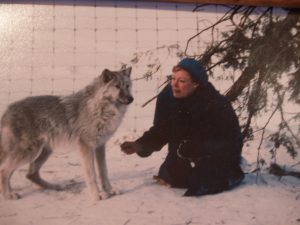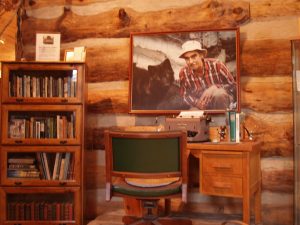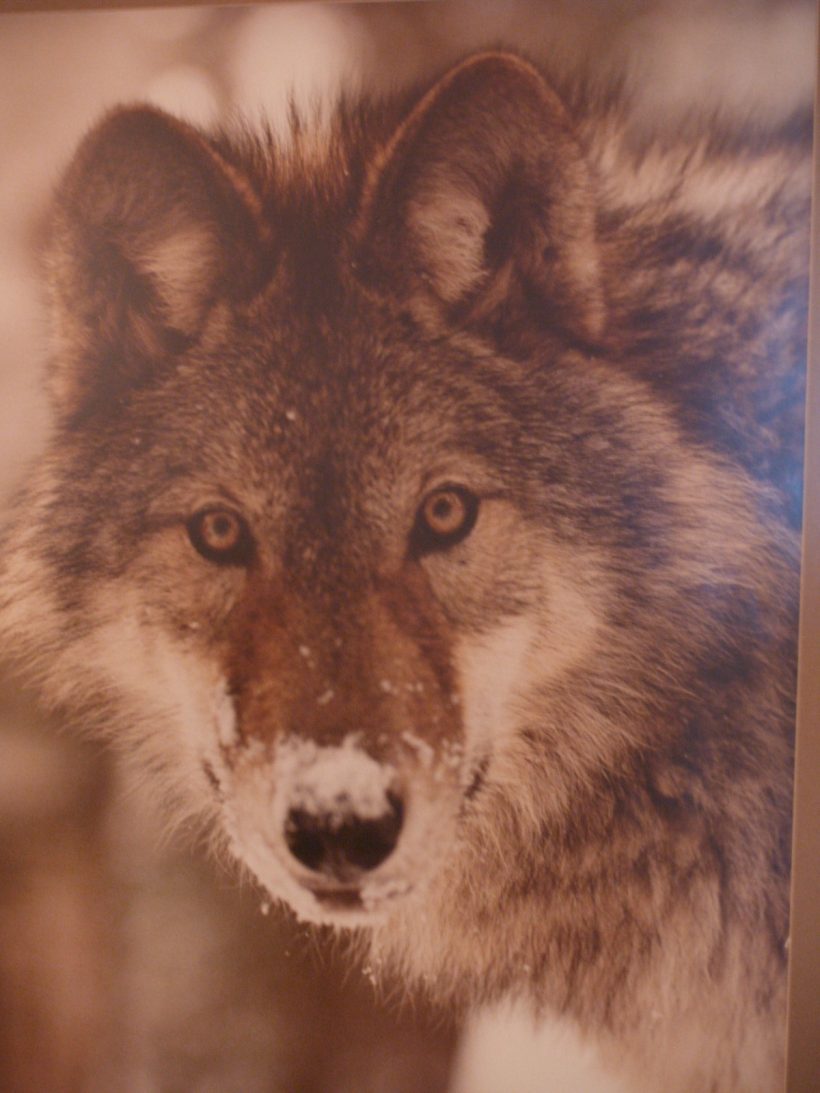R.D. LAWRENCE by BARNEY MOORHOUSE
When I first met R.D. Lawrence in the mid 1980’s he had some 18 books to his credit. Mostly non-fiction out of door wildlife experiences. At the time he had a loyal international following. Like so many artists he was relatively unknown in Canada at that time. Now, there is a centre in Minden named in his honour, The R.D. Lawrence Place. At the time Ron’s first foray into fiction, “Cry Wild”, was fast becoming popular among readers. Although a fictional story it was based upon factual material and at least one school board of the time had included Cry Wild in its enrichment program. Essentially the book featured wolves, a subject very close to Lawrence’s heart.
As readers well know the wolf is a very elusive animal. Only by chance will we generally see one in the wild. And then we can’t be entirely certain. Lawrence himself was wary and elusive. “When the CBC called I knew I was in trouble,” he told me. And yes, that is how I became aware of R.D.’s presence in my neck of the woods. In fact it took me a year or two – if my memory serves – to track him down. I asked many folk and noone had ever heard of him. From the radio interview I knew he had wolves. So I asked the Ministry of Natural Resources. Nothing. I asked butchers. Nothing. Undaunted I continued my search. And then, as I finally discovered Ron’s whereabouts, EVERYBODY knew of him.
Ron’s wife Sharon answered my knock. Ron wasn’t home but Sharon welcomed me in even though they were in the midst of remodeling their home, entertaining film crews from the CBC and Reader’s Digest. I wasn’t entirely unexpected for the word was out that a “writer” was making enquiries.
While we chatted Sharon fed an eight-day old raccoon. After wrist testing the formula she fed it two ounces. Another 4 week old raccoon was sleeping in a nearby “den”. People tended to drop off ill or injured animals. During one visit, while a young raccoon sat on my right shoulder, Ron asked me if I knew whether it liked me or not. “No,” I didn’t.

“It will urinate on you if it really likes you,’ he told me. I was content with just being liked.
In conversation I learned that Sharon’s uncle was Jimmy Frise, the artist who had illustrated many Greg Clarke books. Clarke was an outdoorsman who wrote of his many humourous adventures during the depression era. As a collector of Clarke’s books it once again hit me that this can be a very small world.
R.D.’s mother was Spanish, his father British; he was born during a storm in the Bay of Biscay and christened aboard the British warship, HMS Thunderer. Although Protestant, R.D. attended a Jesuit school in Spain. At the age of 14, while away at camp, the Spanish Civil War broke out. When Lawrence returned home it was empty, ransacked and his family gone.
R.D. recalled meeting author Ernest Hemingway who was working on his novel For Whom the Bell Tolls. Ron helped Hemingway as a translator. Did that experience motivate him to be a writer? “No,” it didn’t. Lawrence’s father was a Reuter’s journalist and years later, after emigrating to Canada, Lawrence, like Hemingway, did work for the Toronto Daily Star.
Following service during World War 2 in the Royal Armored Corp fighting Rommel’s Afrika Korps and later as part of the D Day invasion – he was wounded in both – RD attended Cambridge University to study biology. In 1954 he emigrated to Canada and a life of writing about his adventures living among the cougars of British Columbia or the wolves of northern Ontario. Many of the author’s books reflect his lifestyle at that time. The wilds of nature were his laboratory. RD was not one to accept anything as truth until he had personally verified it. For example, published facts of the time told him that wolves don’t howl in the summer and they never play. The source was a PhD who had some wolves of his own. He had never heard them in the summer because his air conditioner was too noisy and the wolves never played because they were kept in a constantly stressed condition. With RD it was a case of the more he learned the more he realized there was yet more to learn. “On the other hand there are a lot of people who know little and think that they know a lot,” he used to say.
When I first met Ron and Sharon they lived on 100 acres in the Haliburton Highlands where they had erected a large enclosure to house two wolves that they had rescued as pups while on a trip to the Yukon. Of interest, the male, according to RD, was jealous when I approached them and stood between the female and myself. If a woman were to approach he said that the female would become jealous and place herself between the male and woman. Not being part of their pack I was pleased to stay at a distance as advised.
Wolves didn’t entirely dominate RD’s works. His books featured the many animals that he befriended over the years. Through these experiences the reader can escape to another time, to another place. For some enjoyable and informative reading by the warmth of a fire on a cold wintry night I’d recommend: “The North Runner,” The Zoo That Never Was,” and “Voyage of the Stella,” – in that order.
There are some advantages to being a well known author that aren’t immediately obvious. For example, Ron told me that he had submitted a manuscript and the editor returned it demanding that he drop all of the “ing” endings of verbs for some unexplained reason. Ron merely responded that he had another publisher waiting for his works and if the editor insisted on these changes he would go to that publisher. The editor dropped her request.
The advent of computers revolutionized writing for Ron as he could keep several books on the go at a time. When so inspired he merely had to “call up” the appropriate book and proceed.
Lawrence was instrumental in establishing the Haliburton Forest and Wildlife Preserve’s Wolf Centre complete with a captive wolf pack from Michigan. A google search can provide more information and photos to enhance the reader’s experience.

R.D. Lawrence died of Alzheimer’s disease in 2003 at the age of 82 with 30 books, published in 32 countries and 16 languages to his credit. He had six books underway at the time of his passing. The R.D. Lawrence Place opened on April 22, 2008. Constructed by the Fleming College Sustainable Building Programme, the Centre is a sustainable 1900 square foot straw bale building featuring indoor water waste treatment and solar thermal heating. Lawrence’s life is on display including documentaries.
For more information about the centre call 1.705.286.2298 or do a google search.
PHOTOS- All are from the R.D. Lawrence Place in Minden.
2a. Ron’s office. 2b. Thor – photo by Jim Wuepper – a member of the wolf pack moved to the Haliburton Forest. 2c. Sharon Lawrence.
